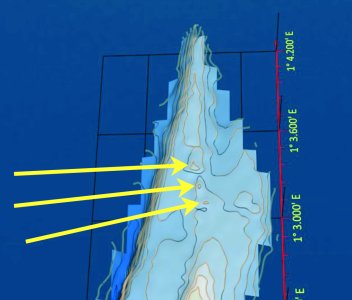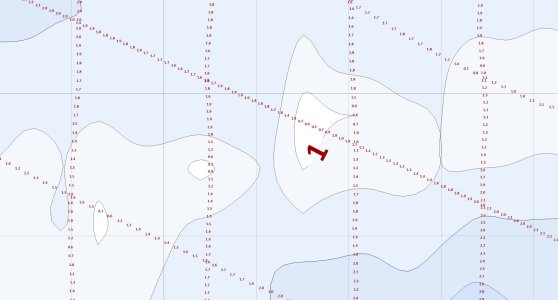tillergirl
Well-known member
Many of you will remember that Larry (aka Gladys) and I had prompted a 'Less water reported 2024' at the Knoll in the Weeks 37 and 38 Notices to Mariners Part 1 thread - well over 500 have looked at the thread!  We had found 'less water' while we were doing a rather unsuccessful experiment over the Knoll back in August and so as a result we went back there on Saturday 7th September. Conditions were perfect; probably the flatest day we have ever experienced so we collected data for over 4 hours. Bizarrely having finished we suffered a complete comfuter (sic) crash. Actually I suffered it but Larry had to ensure the silence on the way back while I lost over 10080 data lines with the permanent lose of not only the primary but also the back-up.
We had found 'less water' while we were doing a rather unsuccessful experiment over the Knoll back in August and so as a result we went back there on Saturday 7th September. Conditions were perfect; probably the flatest day we have ever experienced so we collected data for over 4 hours. Bizarrely having finished we suffered a complete comfuter (sic) crash. Actually I suffered it but Larry had to ensure the silence on the way back while I lost over 10080 data lines with the permanent lose of not only the primary but also the back-up.  BUT!
BUT!  It turned out that I had a second back-up system: cost a few squids for a new bit of software but we retrieved the data; indeed instead of lost 10080 data lines, we had 70787 data lines of data! That was typically a ping every 2ft of 23 n miles or so. Never knew that a second back-up system existed.
It turned out that I had a second back-up system: cost a few squids for a new bit of software but we retrieved the data; indeed instead of lost 10080 data lines, we had 70787 data lines of data! That was typically a ping every 2ft of 23 n miles or so. Never knew that a second back-up system existed. 
I'll get to the point: whilst the overal footprint of the Knoll remains constant, the drying area has moved and increased in size within the overal footprint. The NW Knoll PHB remains in the right place. For those unfamiliar, the Knoll is on the south side of the entrance to the River Blackwater (the SHBs are the Eagle and Bench Head) and there is a tendancy for some to 'straight line' from the Spitway to the Blackwater and pass on the wrong side of the NW Knoll (we do!). On the day we were there, two motor boats passed over the shallow parts of the Knoll or v. close by at full speed so we reflected if they had considered the height of tide. Prior to the 7th September, the latest data available to the UKHO was 1985 which does rather underline the value of checking the source data - but unfortunately it is only available on standard UKHO charts. Checking back on old charts, the drying area in 1903 were identical to today; in 1940, much smaller and a little to the west. Which will tell us that the drying area will move over the years. On a lively day, a spring tide will agitate the waters around and over the Knoll and would be well worth avoiding even if there is plenty of height of tide.
The data has gone to the UKHO and I understand the plan is to provide a NtM for Chart 3741 (Rivers Colne and Blackwater) and for Chart 1975 (Thames Estuary - Northern Part) to incorporate the data in time for the next edition which is expected early next year. There is a CTTE chartlet available (third item) at: Downloads. Click the download button for the pdf files, click on the image for the jpeg. Not the most critical place but we hope it helps.
I'll get to the point: whilst the overal footprint of the Knoll remains constant, the drying area has moved and increased in size within the overal footprint. The NW Knoll PHB remains in the right place. For those unfamiliar, the Knoll is on the south side of the entrance to the River Blackwater (the SHBs are the Eagle and Bench Head) and there is a tendancy for some to 'straight line' from the Spitway to the Blackwater and pass on the wrong side of the NW Knoll (we do!). On the day we were there, two motor boats passed over the shallow parts of the Knoll or v. close by at full speed so we reflected if they had considered the height of tide. Prior to the 7th September, the latest data available to the UKHO was 1985 which does rather underline the value of checking the source data - but unfortunately it is only available on standard UKHO charts. Checking back on old charts, the drying area in 1903 were identical to today; in 1940, much smaller and a little to the west. Which will tell us that the drying area will move over the years. On a lively day, a spring tide will agitate the waters around and over the Knoll and would be well worth avoiding even if there is plenty of height of tide.
The data has gone to the UKHO and I understand the plan is to provide a NtM for Chart 3741 (Rivers Colne and Blackwater) and for Chart 1975 (Thames Estuary - Northern Part) to incorporate the data in time for the next edition which is expected early next year. There is a CTTE chartlet available (third item) at: Downloads. Click the download button for the pdf files, click on the image for the jpeg. Not the most critical place but we hope it helps.





